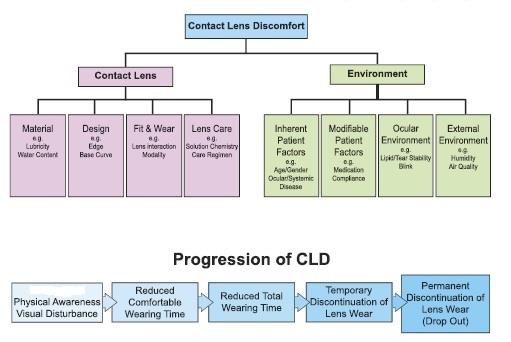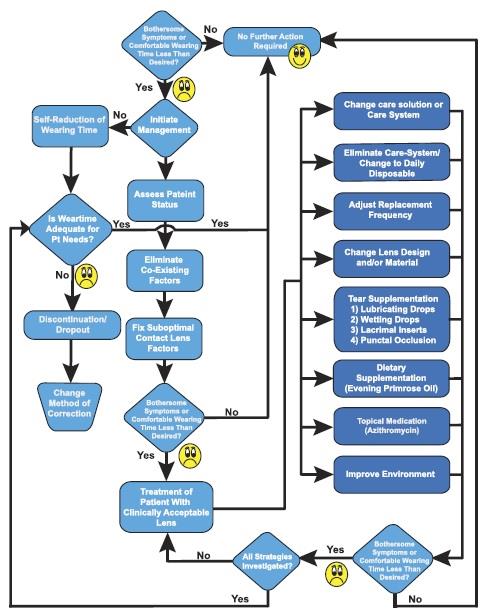
One of the less well publicised outcomes of lockdown and the move to working from home at the computer has been a reported increase in ocular discomfort. Expect a rush of studies verifying this in the months ahead. In many ways, the last few months has represented a microcosm of what was already a developing pattern in recent years, and the challenges of modern living with variable hours, artificial environment control, digital screen use and many other factors all requiring a greater focus from eye care professionals upon the ocular surface and symptoms related to it.
We also know that discomfort is a major reason for the discontinuation of contact lens wear. So, as more of us turn to contact lens correction and make use of the expanded range of lenses available and are able to successfully correct most errors, including presbyopia, a better understanding of the interaction between contact lens and ocular surface would seem an important area to look at if we are to address the problems likely to present to us in practice. To this end, Optician has teamed up with Alcon to produce a number of articles and CET exercises over the coming months which I hope will offer some guidance and new perspective on this topic.
TFOS and CLD
The Tear Film and Ocular Surface Society (TFOS) is a non-profit organisation comprising experts from all around the globe and which has been able, through the publication of reviews of the evidence base undertaken by their workshops, influence our clinical approach to commonly presenting concerns related to the ocular surface. Regular readers will be more than familiar with the TFOS Dry Eye Workshop publications, better known as DEWS and its more recent follow up DEWS2. I suspect fewer may be aware of other publications, including a meibomian gland dysfunction workshop and another looking at contact lens discomfort.
In 2012, some 79 experts grouped into several sub-committes trawled through the literature regarding contact lens discomfort (CLD) and, the following year, produced a report which was published in full by the journal IOVS and which is still freely available to download (go to www.tearfilm.org/ckfinder/userfiles/files/TFOS%20CLD%20FINAL.pdf). It is well worth a read.
This article offers a summary of the main conclusions of the workshop. As with DEWS, the report is split into several sections as follows.
Definition and classification of CLD
There is always going to be some debate about whether symptoms during contact lens wear are triggered by the contact lens itself or are due to pre-existing concerns that become manifest. Also, because of the many associated factors influencing discomfort as already mentioned, any single definition of CLD is always likely to be a generalised one. That said, TFOS gave us the first ever widely agreed definition as follows:
'Contact lens discomfort is a condition characterised by episodic or persistent adverse ocular sensations related to lens wear, either with or visual disturbance, resulting from reduced compatibility between the contact lens and the ocular environment, which can lead to decreased wearing time and discontinuation of contact lens wear.'
As stated in consideration of this definition, ‘Classification of CLD was challenging, as classifying a disease relates to the ability to categorise it based on knowledge of the aetiology.’ TFOS also stated at the time, ‘an understanding of aetiologic factors has been identified in the other subcommittee reports as significantly lacking for CLD.’ In an effort to offer an overview of many various external influences, and also to note the change in symptoms that may occur over time, TFOS produced a diagrammatic summary (figure 1).
 Figure 1: TFOS classification of contact lens discomfort (CLD)
Figure 1: TFOS classification of contact lens discomfort (CLD)
Epidemiology of CLD
The subjective nature of discomfort means that there is some variation in the reports of prevalence for the condition and this is always likely to be the case. That said, the use of questionnaires is useful and will continue to be a mainstay of our clinical work.
Contact lens matters
This section recognises the importance of lens materials, wearing regimes, care systems, replacement frequency and so on upon CLD. The overall point raised, however, is that ‘to our knowledge, large-scale, well-controlled studies using contemporary devices have not been conducted to provide insight into these issues.’ There has certainly been some rectification of this since 2013.
Neurobiology of discomfort and pain
This section concluded that a great deal of future work is needed before we really understand the way discomfort results from the ocular surface. Though the anatomical innervation is known, physiological changes that have been observed, such as an increased threshold of corneal sensitivity during orthokeratology lens wear or an apparent dissociation between CLD and the influence of soft lens wear upon corneal touch response, have yet to be adequately explained. It was noted that ‘An important first step would be to design experiments to determine which tissue (eg corneal or lid margin) is the primary sensory location of CLD.’ This is still yet to be conclusively determined.
CL interactions with the ocular surface
The sub-committee concluded, ‘some evidence is available to suggest a link between conjunctival and lid changes with CLD, with the strongest evidence being that related to meibomian gland and lid wiper epitheliopathy changes. No convincing evidence of a link to CLD was unearthed with respect to any of the other forms of CL-associated tissue changes.’
CL interactions with the tear film
Though it was noted that ‘there are significant gaps in our understanding of the extent to which tear film changes in contact lens wear are responsible for CLD,’ it was also established that tear film stability and evaporation were important influences upon CLD. This finding has undoubtedly influenced the development of lens surfaces more able to minimise CLD since the report was produced.
Management of CLD
After a section looking at the design of existing trials into CLD and recommendations for future trials, there is a useful section on the management and treatment of CLD. This is usefully summarised by a flow chart which is reproduced in figure 2.
 Figure 2: TFOS summary of the management strategies for CLD
Figure 2: TFOS summary of the management strategies for CLD
Conclusions
A fair summary of the report might be that CLD is important, a common problem, is influenced by a wide range of factors and that much more work is need to pin down precise details of CLD. That said, there is a good deal of useful advice for the management of CLD to be offered by the clinician in practice.
